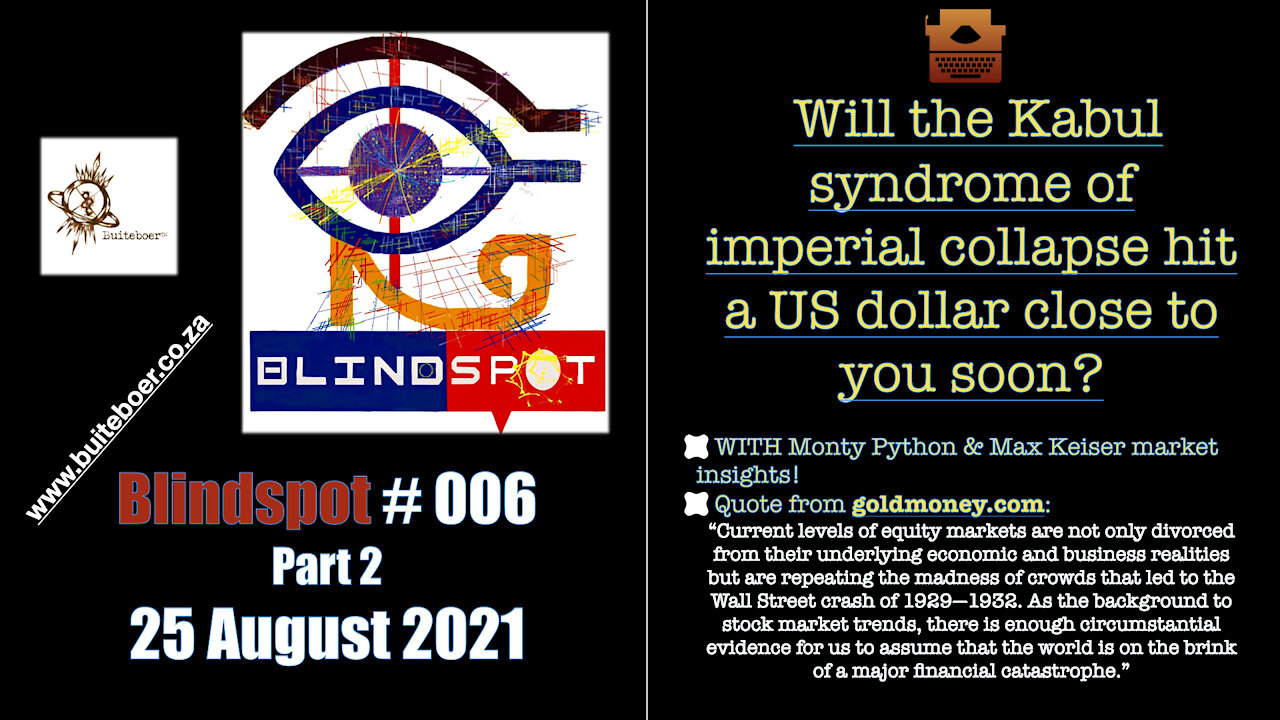Premium Only Content

Blindspot #006 ->> Part 2 - Will the Kabul syndrome hit a US dollar close to you soon?
Is the Kabul syndrome going to hit a US Dollar close to you soon?
For the #006 Part 2 blog with more information, go to: https://buiteboer.co.za/2021/08/25/blindspot-006-part-1-2-will-the-kabul-syndrome-hit-a-us-dollar-close-to-you-soon/
I - The US dollar and gold standard
Since the Second World War, the US dollar has been the anchor currency of global trade, with the US Federal Reserve as centrepiece of the global financial architecture - including western dominated Bretton Woods institutions, such as the International Monetary Fund. A watershed moment in that history was the decision to move the US dollar away from the gold standard in the early 1970s. Since then unbacked fiat currencies (with mysterious floating values) have blossomed and flowered. However, persistent money printing in the northern hemisphere (since 2008, and accelerating since the COVID pan(dem)ic erupted) is leading to a market crash of rather epic proportions.
Nevertheless, the little bit of ‘history’ above is relevant for the question as to whether the Kabul syndrome of imperial collapse, will be hitting a US dollar close to you soon. This is due to the fact that the world system is, in the turbulent twenties of this century, clearly at a major inflection point.
II - Is the US & NATO’s disgraceful Afghan departure ushering in the era of the Shanghai Cooperation Organisation?
With the US/NATO disgracefully backing out of twenty years of shooting themselves in the foot in Afghanistan, it is clear that power dynamics on the multi-layered central Asian chessboard will tip decidedly in favour of nations that are members of the Shanghai Cooperation Organisation (SCO). The Islamic Republic of Iran is an observer nation in the SCO context, and rumours indicate that there may be a strong push coming from China, to advocate for Iran to transition to full membership. This geopolitical context is critical in a period where US global ‘military prowess and power’ is exposed as nothing but empty posturing.
III - How will the Kabul syndrome manifest in the US dollar?
The Kabul syndrome of collapse, deceit, and defeat is manifesting in the US dollar as well. But how? It is in the inflation numbers that have been coming from the USA. While the mainstream press report on rising inflation in the USA, and UK, for example, but do not for a moment underestimate the monstrous risks chasing us in the economic blindspot.
Blindspot talks through the highlights of an extremely insightful article on goldmoney.com entitled: 2020 - 2022 vs 1929 - 1932. Some highlights from the article include:
“In the past I have compared the current market situation with 1929, when the US stock market suffered a major collapse that October. With memories short today, many will have even forgotten that between 12 February and 23 March last year the Dow Jones Industrial Index fell 38.4% top to bottom in less than six weeks, paralleling the 66% fall between 4 September and 13 November 1929 on an eerily similar timescale.”
“As the background to stock market trends, there is enough circumstantial evidence for us to assume that the world is on the brink of a major financial catastrophe. The list of negatives is growing. It started with the US repo market blow-up in September 2019, followed by the Dow losing 35% in nominal points between 10 February and 23 March 2020 (as pointed out above) before the Fed stepped in to rescue the stock market by cutting the funds rate to the zero bound and reinstating QE to the unprecedented extent of $120bn every month, along with several other market-enhancing measures. They worked. At least, that is, if you ignore the costs and consequences.”
David Goldman, recently reflected in an article on the Asia Times platform that the world has to prepare itself for persistent inflation in the US economy. He is of the view that regular economic commentary suggesting that inflation in the USA is a ‘temporary’ phenomenon, is nothing but part of a grand economic smoke & mirror numbers game.
Goldman argues: “The scare headline about Thursday’s Producer Price Index release said that the year-on-year jump of 7.7% was the biggest on record. That’s for the PPI “final demand” index, which starts in 2010, long after the horrendous inflation of the 1970s had become a distant memory.”
IV - How does this impact on South Africa?
Chris Harmse, from CH Economics, argues in an article entitled - US sneezes, South African markets catch a cold, that:
“…last week once again showed how vulnerable South African financial markets were to economic and geopolitical events in the US. The hawkish fashion in which the Federal Reserve Open Market Committee (FOMC) warned that the quantitative easing in the US (and the current record low bank rate) may come to an end sooner than later, had devastating effects on share prices in South Africa and the rand. The all share index fell 4.9 percent last week, its sharpest decline since the 15.2 percent decline during the first week of lockdown in March 2020. The rand had softened by 61c against the dollar last week from R14.70 the previous Friday, to R15.31.”
Clearly the threat of ‘tapering’ the QE printers in the USA had a direct and nearly immediate impact on the South African currency and economy. The major risk and blindspot to consider is the warning implied in the analyses shared here, being that a collapsed, or collapsing US dollar, can and will, like a black hole, suck all other fiat currencies with it down the toilet once the moment of collapse, retreat, and Kabul-style dollar defeat comes.
V - What to expect?
The time might be right for BRICS, and members of the African Continental Free Trade Area to seriously consider currency alternatives to the sinking US dollar ship.
And lastly, according to goldmoney.com, the best way to preserve wealth under such volatile market conditions is by holding physical silver, or gold.
-
 LIVE
LIVE
MattMorseTV
1 hour ago🔴It's EVEN WORSE than we thought...🔴
725 watching -
 LIVE
LIVE
SpartakusLIVE
1 hour ago#1 Rocket CHAMPION of Verdansk wields UNSTOPPABLE new META
308 watching -
 56:41
56:41
Donald Trump Jr.
2 hours agoFull Court Press: Sen Eric Schmitt Writes New Playbook for the Left's Lawfare | TRIGGERED Ep.270
44.7K33 -
 1:17:26
1:17:26
Katie Miller Pod
1 hour agoEpisode 3 - Senator Katie Britt | The Katie Miller Podcast
5.34K -
 1:05:24
1:05:24
BonginoReport
2 hours agoTrump Protects Old Glory in New EO! - Nightly Scroll w/ Hayley Caronia (Ep.119) - 08/25/2025
59.2K19 -
 LIVE
LIVE
The Jimmy Dore Show
1 hour agoSnoop Dogg Is DONE w/ LBGTQ+ Propaganda In Kids Movies! Trump Outlaws Burning the U.S. Flag!
5,358 watching -
 LIVE
LIVE
Quite Frankly
5 hours ago"Weekend News, All-Time Physical Feats, Mixed Reels" 8/25/25
464 watching -
 LIVE
LIVE
The Mike Schwartz Show
2 hours agoTHE MIKE SCHWARTZ SHOW Evening Edition 08-25-2025
4,151 watching -
 1:43:44
1:43:44
MTNTOUGH Podcast w/ Dustin Diefenderfer
17 hours agoEddie Penney: DEVGRU to Single Dad of 3 Overnight | MTNPOD #130
222 -
 1:28:57
1:28:57
Kim Iversen
2 hours agoSomeone Stole Kim's Identity — And Bought a Car! | Dr Drew Pinsky On Sex, Drugs & Censorship
34.7K19